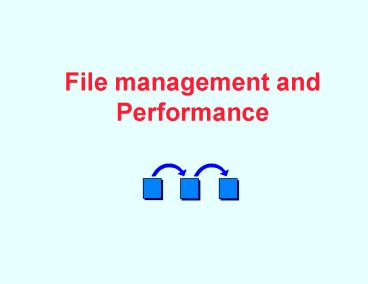File management and Performance PowerPoint PPT Presentation
Title: File management and Performance
1
- File management and Performance
2
- File Systems Architecture
- File organization and access
- sequential
- index-sequential
- direct
3
- File sharing and blocking
- File sharing
- access rights read, write, execute, by user
classes. - File/record locking simultaneous access
- Record blocking
- Logical vs physical record
- unblocked vs blocked record
- fixed-lenght vs variable-lenght
4
- File allocation
- File allocation table (FAT)
- Pre allocation vs dynamic allocation
- Portion size
- contiguity increases performance
- fixed-size portions simplify reallocation
- variable-size or small fixed-size minimizes waste
of unused space for overallocation - two main alternatives
- variable, large contiguous portions (performance)
- small fixed portions (flexibility)
- File fragmentation and reorganization
5
Redundant Array of Independent/ Inexpensive
Disks (RAID)
- RAID is a set of physical disk drives viewed by
the OS as a single logical drive - Data are distributed across the physical drives
of an array - Redundant disk capacity is used to store parity
information, which guarantees data recovery - RAID Levels various levels of performance and
redundancy - the disks are divided in strips physical blocks,
sectors, or similar - the strips are mapped round robin on the array
- I/O requests can be processed in parallel
6
- Performance
- How effective is the OS in managing resources?
- Overall performance measures
- turnaround time
- response time
- throughput
- workload
- capacity
- utilization
- Bottlenecks
7
- Evaluation Techniques
- Timings (hardware)
- Instruction mix (software mix)
- Kernel (typical program)
- Benchmarks (comparison between systems)
- Synthetic programs
- Analytical models and simulation
- Commercial performance packages
8
- Performance enhancement
- coprocessing
- parallel processing
- the RISC vs CISC controversy
- CISC
- frequently used code as (complex) instructions
- increase lower level programming productivity
- extensive market penetration
- RISC
- very few of the complex instructions are used
(empirical studies) - therefore a reduced instruction set is more
efficient - programs are 20 larger , requiring more disk
space and memory - much more registers are needed, but speed of
programs written for RISC is close to twice of
equivalent for CISC. - facilitate scalability
PowerShow.com is a leading presentation sharing website. It has millions of presentations already uploaded and available with 1,000s more being uploaded by its users every day. Whatever your area of interest, here you’ll be able to find and view presentations you’ll love and possibly download. And, best of all, it is completely free and easy to use.
You might even have a presentation you’d like to share with others. If so, just upload it to PowerShow.com. We’ll convert it to an HTML5 slideshow that includes all the media types you’ve already added: audio, video, music, pictures, animations and transition effects. Then you can share it with your target audience as well as PowerShow.com’s millions of monthly visitors. And, again, it’s all free.
About the Developers
PowerShow.com is brought to you by CrystalGraphics, the award-winning developer and market-leading publisher of rich-media enhancement products for presentations. Our product offerings include millions of PowerPoint templates, diagrams, animated 3D characters and more.

